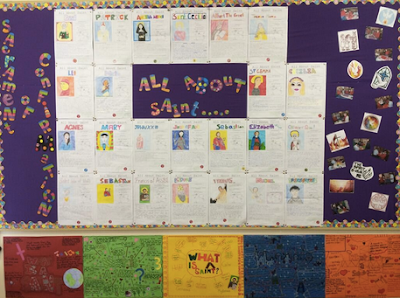Religious Education 2014
Teacher- Anna Sheehy
The Year Six students have been preparing for the Sacrament of Confirmation. As a part of their preparation several tasks were set up in order for them to deeper their knowledge about their chosen saints and the Process of Canonisation.
Teacher- Anna Sheehy
The Year Six students have been preparing for the Sacrament of Confirmation. As a part of their preparation several tasks were set up in order for them to deeper their knowledge about their chosen saints and the Process of Canonisation.
A website was created so that students had
access to their tasks, resources and rubrics throughout the whole process.
Students have been visiting this website on many occasions to make sure they
are up to date with each task and checking off each part of the rubrics to make
sure they are submitting everything.
Students have been working on these tasks
throughout Term Two and are currently of Task Four. Below you will find a brief
outline of the tasks that the students have been working on.
Task One:
The first task for students was to find out ‘what
is a saint?’ Students watched a Flipped Task and prepared some research
about what constitutes a saint.
Once this was completed, they were grouped and asked to share their research. They then presented their information, outlining the main characteristics of a saint.
Each group created a large poster outlining all of their key points.
Once this was completed, they were grouped and asked to share their research. They then presented their information, outlining the main characteristics of a saint.
Each group created a large poster outlining all of their key points.
Task Two:
The
second task that the Year Six Students needed to complete was a research stage.
They needed to research the Saint whose name they were taking for
Confirmation.
Students needed to include information about their early life, education, and a timeline of the significant events of their saint’s life.
As a class, we explored TimeGlider. This is an online timeline creator tool. Each student set up an account with their school email address and then we did some explicit lessons and some Flipped Tasks related to using the tool.
Students needed to identify examples of how the influence of the Holy Spirit can be seen in the life events and words of their saints and complete an expose of their lives.
Students needed to include information about their early life, education, and a timeline of the significant events of their saint’s life.
As a class, we explored TimeGlider. This is an online timeline creator tool. Each student set up an account with their school email address and then we did some explicit lessons and some Flipped Tasks related to using the tool.
Students needed to identify examples of how the influence of the Holy Spirit can be seen in the life events and words of their saints and complete an expose of their lives.
http://timeglider.com/timeline/c81e975ee051cfa3
They also needed to outline the reasons why they make a good Saint, explain why they chose this Saint, and how they relate to them and their story?
They also needed to outline the reasons why they make a good Saint, explain why they chose this Saint, and how they relate to them and their story?
I
encouraged students to be creative with their presentations, letting them
choose how they wished to present it to their peers.
Task Three
During Task Three, students needed to
research the process of Canonisation. Canonisation is the act by which the
Holy Father declares that a Catholic Christian is in the glory of Heaven, that
is they have been declared a Saint.
There are certain steps that are required to be undertaken in the process of Canonisation and the students needed to display this in the form of a flow chart.
There are certain steps that are required to be undertaken in the process of Canonisation and the students needed to display this in the form of a flow chart.
Some of the students decided to use easel.ly to create
an infographic outlining the process. This is a free web based tool that the
students are very capable of using. Other students used Comic Life and some
opted to create a poster by hand. It was great to see a range of resources
being used.
Here is a video briefly showing some of the finished
products.
Task Four:
The Year Six students are currently working
on Task Four. In this task students needed to define what they think are the
ten main qualities of Saints. They needed to create a definition for each of
these and then think of someone, whom they know, who displays these Saint-like
qualities.
These students needed to interview this
person about the ten qualities they had chosen and are now using this
information to create a 2-3 minute speech.
All of the Year Six students are confident
speakers and will be well prepared for their speeches. I am very much looking
forward to the listening to each of them.
There is a final task where students will
be researching Australian heroes who they feel may be Saints in the future.
Students will be creating a persuasive argument in an online format to complete
this task.














